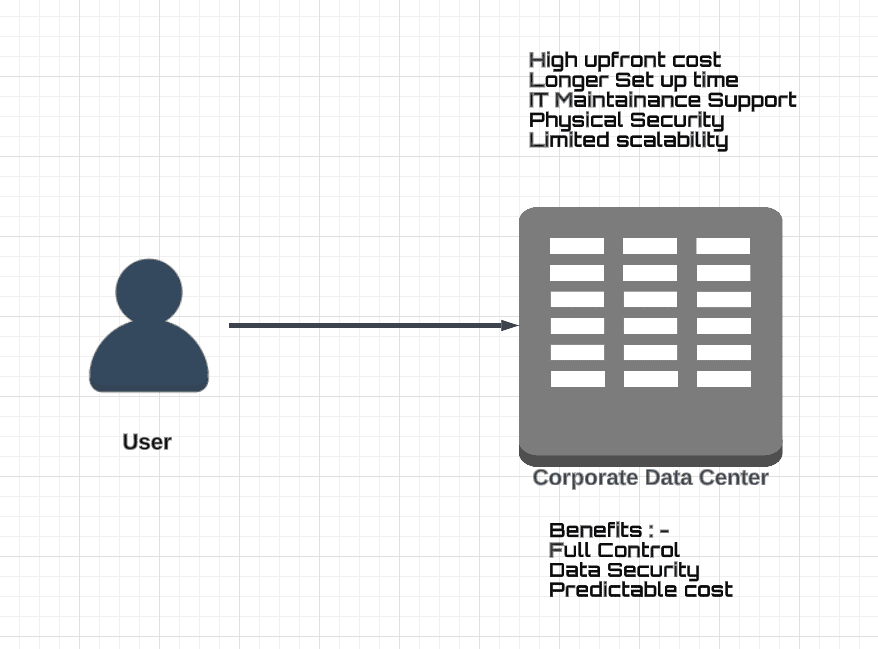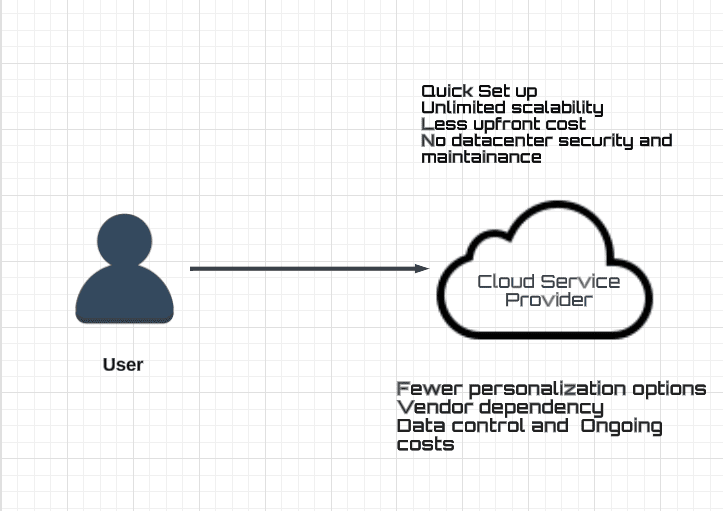In this blog, we will explore the disparities between on-premises and cloud infrastructures, highlighting their respective benefits and drawbacks.
What is an On-Premises Architecture?
An on-premises data center refers to a physical facility owned and operated by an organization, serving as a central hub for managing and housing its own IT infrastructure. This infrastructure includes servers, networking equipment, storage devices, and other hardware components. Within an on-premises data center, the organization has complete control over the infrastructure, software systems, security measures, and overall management of the data center environment.
Typically, on-premises data centers are located either within the organization’s premises or in a dedicated nearby facility. They are purposefully designed to meet the specific requirements of the organization, allowing for customization to effectively address the organization’s unique IT needs.
Setting up an on-premises IT infrastructure involves establishing a data center, procuring physical hardware and licenses, and installing the necessary software. This process can take weeks or even months for complex architectures. It requires collaboration among different teams, such as Hardware, Networking, and IT Support, to complete the setup. Even after the upfront costs, it may take months for the organization to test whether the infrastructure meets their requirements and performs as expected. If the on-premises infrastructure falls short of the organization’s needs, adjustments may require new hardware and software. This entire process represents a significant upfront cost in terms of both time and money for any organization, resources that could be better utilized focusing on core business functionality.
Figure 1 shows a user connecting to an on-prem data center which is self-managed.

Figure 1: Illustration of a user using on-premises data center.
It is the responsibility of the user or team responsible for managing the infrastructure to ensure that servers are functioning, physically secure, and that software and hardware are regularly maintained and updated. The diagram above highlights certain concerns, including the need for additional personnel for maintenance, high initial costs, and a potentially longer setup process.
On-premises refers to information technology infrastructure hardware and software applications that are hosted on data centers owned/leased by companies. Organizations and businesses have substantial control over the underlying infrastructure.
The key strengths organizations get from on-premises infrastructure are:
- Control of hardware and software: Customers exert great control over the hardware and software stacks. Customers can customize their own configurations, upgrades, and system changes.
- Fine-grained control in areas of responsibility: Customers have low-level control over governance and regulatory compliance, as well as other areas for which they are solely responsible.
- Internet connectivity does not have to be a dependency: An on-premises architecture can be configured so that Internet connectivity does not have to be a requirement for software access. In an on-premises environment, the infrastructure and applications are hosted and managed within the organization’s own physical premises or dedicated data center. The data and services are accessed and operated within the local network, without relying on an external internet connection for their core functionality.
- Lower Total Cost of Ownership (TCO): An on-premises architecture can have a lower TCO from a licensing perspective. In an on-premises environment, organizations typically purchase software licenses upfront and own them indefinitely. This means they have the freedom to use the software without ongoing subscription fees or recurring payments. They can negotiate licensing agreements and terms directly with the software vendors, potentially securing better pricing based on their specific needs and usage patterns.
- Predictable cost: Organizations have more control over their costs as they make upfront investments in hardware and software. This allows for better cost predictability and the ability to allocate resources according to the organization’s budget and needs.
The on-premises infrastructure does possess a few drawbacks:
- Large initial investment: The on-premises infrastructure requires large hardware and software purchases, which represent significant upfront costs. Maintenance, including support and upgrades, represents additional costs.
- Longer setup and implementation time: The on-premises infrastructure set-up can take a considerable amount of time for installation, especially for complex systems like a database management system, which typically requires more than just installing a piece of software and letting the users used it.
- Responsibility for maintenance: With the on-premises infrastructure, the customer is responsible for maintaining their own server hardware, software, storage, disaster recovery, etc.
What is the Cloud and How Does It Compare to On-Premises Architecture?
The Cloud represents on-demand delivery of IT resources over the Internet. Organizations do not need to manage hardware and software in the Cloud. Instead, customers pay for resources like storage, compute, high availability/disaster recovery, and other services as they use them. Cloud service providers charge customers at well-defined intervals, at a granularity as low as per-second billing for resources. Resources can generally be configured and acquired, configured, and removed easily and quickly (often with a few mouse-clicks), and, hundreds of services are available to customers.
Figure 2 shows a user connecting to a cloud provider.

Figure 2: Illustration of a user using cloud services.
The Benefits of Cloud Architecture include
- Quick deployment: Customers don’t need to provision any hardware, and software can be deployed within minutes. This can drastically reduce time-to-market.
- Scalability: The biggest advantage of Cloud Computing is that a customer pays only for what they use. In situations where more storage, or greater compute power, is needed, the customer can dynamically and easily scale up their application. In doing so, they pay only for the additional resources used rather than spending money on physical hardware purchases. When the additional resources are no longer needed, the customer can quickly and easily scale down to their normal usage level again.
- No hardware maintenance: A customer doesn’t need to worry about maintenance of hardware or data center; and physical security is the responsibility of the Cloud provider.
- Affordable: Cloud providers require no upfront cost. Customers can make regular monthly payments or negotiate a longer-term contract with a Cloud provider to save money and gain more benefits. Customers can start their journey with initial monthly payments and later engage in a longer-term contract when their application is stable, giving them the best of both worlds.
- Disaster Recovery and Business Continuity: Cloud service providers typically provide reliable disaster recovery and backup solutions. They replicate data across multiple data centers, guaranteeing data resilience and reducing the chances of data loss. This capability allows organizations to swiftly recover from disasters and ensure uninterrupted business operations.
- Cutting-Edge Technologies: Cloud providers make consistent investments in cutting-edge technologies like artificial intelligence (AI), machine learning (ML), and the Internet of Things (IoT). Through cloud services, organizations can harness the power of these technologies without the requirement of significant infrastructure or specialized expertise in these domains.
The Drawbacks of the Cloud Architecture are:
- Less customization: Although Cloud providers 100’s of services to choose from and expose many customization options and, customers can apply more fine-grained customizations to their on-premises data centers as compared to Cloud providers. The on-premises model provides greater control over the operating system, software, etc.
- Long term contracts: Starting with a Cloud provider is often cheaper, but over a long-term period it can be more expensive. This can be due to data transfer costs, moving data in and out of the cloud can be costly, particularly for large volumes of data. After a business has made a commitment to a specific cloud provider, transitioning to an alternative provider can be challenging and may incur considerable expenses and disruptions. As a result, this scenario may result in reduced competition and higher costs over the long run.
- Connectivity: Using the Cloud requires reliable and sufficient Internet connectivity. Regional, or Internet-wide, Cloud provider outages may adversely affect your productivity.
- Data Security Concerns: Storing confidential information in the cloud gives rise to apprehensions regarding the security and privacy of data. Organizations must place their trust in the security measures and data handling practices of their chosen cloud service provider. Unauthorized access or breaches in cloud-stored data can lead to significant repercussions.
- Cost Management: Although cloud architecture provides flexibility and scalability, inadequate management can lead to unforeseen expenses. It is crucial for organizations to closely monitor their usage of cloud resources and optimize their configurations to prevent excessive spending.
Conclusion
While both on-premises and cloud computing offer distinct advantages and disadvantages, I would like to share my perspective on the reasons behind the increasing adoption of cloud computing. The current era is witnessing an unprecedented pace of technological advancement, characterized by the rapid evolution of various technologies. One significant trend in the industry is the increasing adoption of cloud solutions. This shift is primarily motivated by the fact that companies no longer must bear the burden of maintaining specialized expertise. Furthermore, the process of installing software in the cloud is considerably faster compared to the traditional approach of purchasing, installing, and managing costly servers independently.
By embracing cloud solutions, companies can prioritize their core business activities instead of diverting valuable time and resources towards the upkeep of complex infrastructures. Moreover, organizations benefit from the flexibility to easily add or remove resources across different performance classes, enabling swift adjustments to meet changing demands. This eliminates the need for protracted procurement processes that would otherwise consume months of valuable time.
Another advantage lies in the vast array of services offered by cloud service providers. Organizations are not limited to using cloud services solely for storage purposes. Instead, they gain access to a broad range of services spanning numerous domains, expanding their capabilities beyond storage, and empowering them to leverage the full potential of cloud computing.
Overall, the relentless advancement of technology, coupled with the inherent benefits of cloud solutions, has prompted organizations to embrace this paradigm shift. By harnessing the power of the cloud, companies can streamline their operations, focus on core competencies, and avail themselves of a wide array of services to drive innovation and stay competitive in today’s fast-paced digital landscape.



Load comments